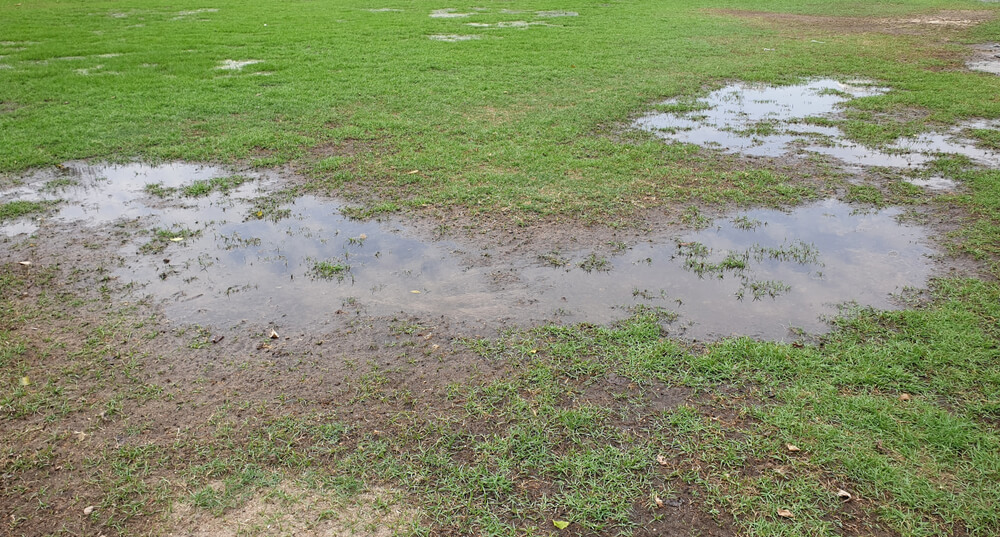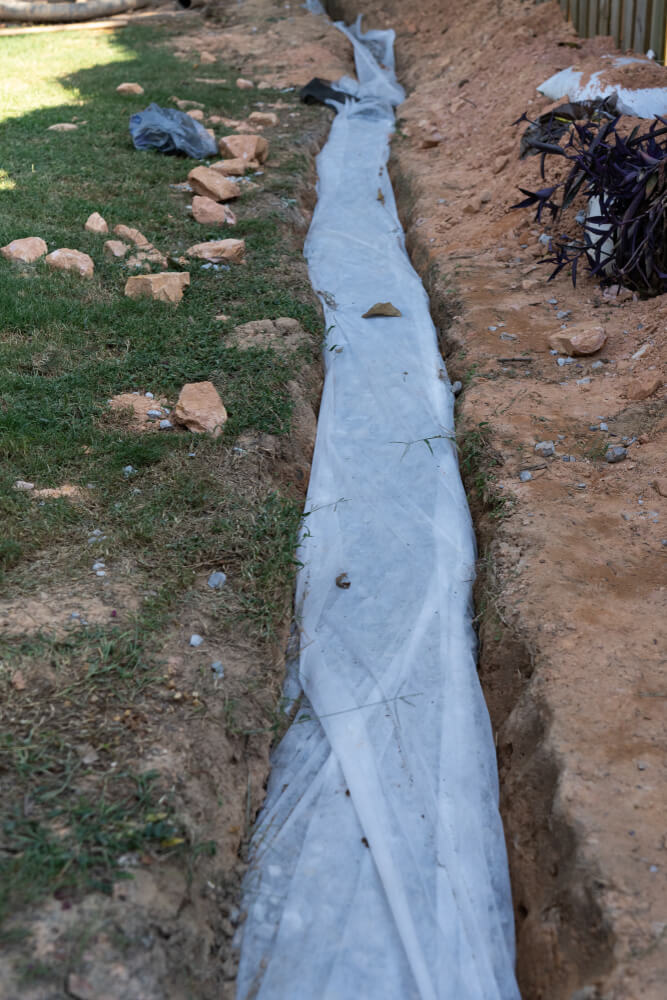Proper Sump Pump Drainage for Lexington & Louisville, Kentucky
Is your yard soggy and boggy for days and days after it rains? It may be a sign of a serious drainage problem.
Sump pumps are designed to direct water out of your basement and foundation, and away from your home to prevent damage. The sump pump discharge should lead water away from your foundation toward somewhere it can properly drain.
If the water isn’t directed somewhere where it can properly drain, you are left with a bevy of problems. Depending on the slope of your property and the type of soil you have, you could be left with standing water. This standing water is a prime mosquito breeding ground, not to mention a whole lot of mud.
A muddy yard makes it very difficult to enjoy. Standing water can also choke out your grass, trees, and other plants, which could kill them.
Common Water Drainage Issues in Kentucky & Southern Indiana

There are several water drainage issues common in Kentucky and Southern Indiana that contribute to standing water.
The first issue is that shallow groundwater is fairly common in this area. This means that rainwater doesn’t easily seep into the ground because the soil is already saturated with water from sources below.
Clay soils and compacted soils are especially common in subdivisions built over old farmlands. Decades of plowing combines and heavy construction equipment have created hard-packed earth. This packed earth cannot hold as much water as normal soil.
Clay soils and compact soils also create an impermeable barrier that prevents water from going very deep into the earth.
Ensuring Proper Drainage for Sump Pumps
There are a number of great solutions for proper sump pump drainage. The most ideal solution is extending your sump pump discharge to drain into a nearby local storm drain. A certified plumber will work with you and the city to connect your sump pump to the nearest storm drain to give proper drainage and keep your sump pump from discharging into the yard.
It Is Illegal to Connect to the Sanitary Sewer System
When working to connect the sump pump to a nearby storm drain, you must contact the city to ensure you are connecting to the correct drainage system. It is illegal to connect to the city sanitary sewer. When it rains, and your sump pump or downspouts are connected to the city sewer, the extra water can cause sewage to backflow into homes. It can take as few as four sump pumps in a neighborhood connected to the sewage system to overwhelm the system and cause backflows.
Both Lexington and Louisville have programs for disconnecting sump pumps and downspouts from the city sewer system.
The Lexington Sump Pump Redirect Program will pay up to $3,000 for a plumber to disconnect your qualifying sump pumps from the sanitary sewer.
Louisville’s MSD will pay for sump pump redirection, as well as up to $100 per downspout redirected from the sewer system for qualifying homeowners.
Alternative Sump Pump Draining Solutions
If you don’t have access to a nearby storm drain, there are a few other alternative sump pump draining options available to you. A plumber or landscaper can work with you to create a dry well or French drain. You can route water to a lower spot in your yard and plant a “rain garden” of water-loving trees and plants to soak up excess water.
Here are some options if you have no other choice but to route your sump pump discharge into the yard.
 French Drains
French Drains
Not all wet zones are caused by soil compaction. It could be that low-lying or flat areas of your lawn are subject to pooling because of lack of slope. In these situations, an underground drainage system will help redirect water and dry out the lawn. French drains only work if there is a lower place to drain the water.
To build a french drain, dig a trench. Line the trench with filter fabric and pour a gravel bedding. At the beginning of the trench, place a water inlet grate where the water pools the most. Then, lay the pipe to drain the water. The pipe can be made of longer-lasting PVC pipe or made of a more flexible drainage hose. Drill holes every six inches along the length of the pipe, making sure they face downward to let some water escape along the way.
Test the pipe, then cover it with about three inches of gravel and filter fabric. Then, backfill the whole thing with topsoil.
Some pipe systems also use a gravel-free approach if you want to spend a little more on the pipe. It uses corrugated pipe surrounded by polystyrene aggregate that is then wrapped in filter fabric.
Dry Creek Bed
Similar to the French drain, the dry creek bed is simpler to construct. Dig a ditch, line it with filter fabric, and then use assorted rocks to armor the sides of the channel. On either side of the channel, you can lay down landscaping fabric and mulch. Finish it by planting perennials and shrubs to soften the edges and give it a natural look.
Dry Well
If you need to drain your sump pump discharge into the yard, a dry well is a great option.
A dry well penetrates the compacted soil and lets water drain deeper into the earth. You can connect your sump pump or downspouts to a dry well to help water drain. Warning: digging a dry well is a lot of work!
To build a dry well, first, you need to find the right spot. It needs to be a minimum of ten feet away from your foundation, but further away is better. You’ll then be digging a four-foot deep and wide hole. The hole is covered in landscaping fabric, and a drainage barrel, a plastic barrel with drainage holes, is installed.
The pipe is connected to the sump pump or downspout and then is run to the drainage well. The barrel is surrounded by gravel, and then the whole thing is covered up again elegantly with topsoil and grass. This Old House provides an excellent detailed guide on How to Install a Dry Well.
Rain Garden
To create your rain garden, create a depression with a berm on the low side of your property to intentionally collect rainwater. Then, plant water-loving plants such as sedges, cardinal flowers, bluestar, swamp hibiscus, and others.
Talk with your local nursery to find the best plants for your rain garden. Rain gardens will reduce flooding, filter pollutants from the water, and provide habitat for birds and pollinators. You can also use a french drain or a dry creek bed to funnel water to your rain garden.
There are many things to consider when trying to drain excess rainwater, causing a constantly wet yard. It’s best to bring in a professional to ensure you aren’t wasting time and money on a solution that won’t fit your particular circumstances.
Contact Dauenhauer at any hour, and we’ll provide a free, reliable quote to get all that water moving in the right direction—away from your basement!